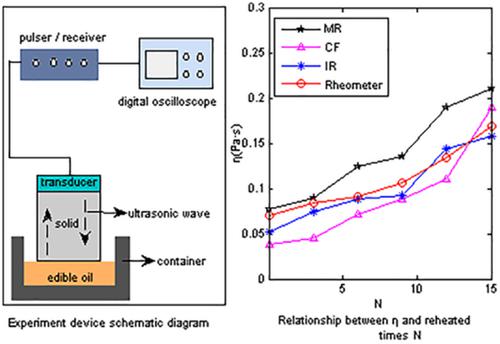当前位置:
X-MOL 学术
›
J. Food Process Eng.
›
论文详情
Our official English website, www.x-mol.net, welcomes your feedback! (Note: you will need to create a separate account there.)
Ultrasonic shear-wave reflectometry applied to monitor the dynamic viscosity of reheated edible oil
Journal of Food Process Engineering ( IF 3 ) Pub Date : 2020-03-10 , DOI: 10.1111/jfpe.13402 Hu Runrun 1 , Mo Runyang 1 , Wang Chenghui 1 , Hu Jing 2
Journal of Food Process Engineering ( IF 3 ) Pub Date : 2020-03-10 , DOI: 10.1111/jfpe.13402 Hu Runrun 1 , Mo Runyang 1 , Wang Chenghui 1 , Hu Jing 2
Affiliation

|
Effects of frying cycles of two types of edible oil on dynamic viscosity were studied by ultrasonic shear‐wave reflectance method. Factors affecting the reflection coefficient were analyzed theoretically. The experimental methods and parameters are carefully analyzed and optimized in the low‐viscosity case. The viscosity of the reheated oil samples was characterized by the reflection amplitudes at (25 ± 0.2)°. Three methodologies for data post‐processing were used to calculate the reflection magnitudes. The results show that viscosity increases with repeat times of heating. The viscosity obtained by the integral ratio in a frequency band is closer to those obtained by rheometers than those from central frequency and multiple reflection. It indicates that the shear‐wave reflectometry can be extended further used to measure low‐viscosity liquids by appropriate signal processing. In addition, the heating times of a given procedure is highly correlated with the viscosity of edible oil (R² > .93). We also attempted to evaluate the oil deterioration by predicting the amounts of carbonyl and fatty acids based on the relationship between viscosity and indicator content. PRACTICAL APPLICATIONS: Viscosity is an important physical property and a quality index of edible oil. Not only viscosity changes, aging, and decay phenomena will even occur in the process of repeated heating of edible oils at high temperature. As a convenient and nondestructive method, the ultrasonic shear‐wave reflectance method can realize the rapid detection of the viscosity of reheated oils in situ. Therefore, this method has the potential to monitor frying oil quality online, which is expected to evaluate the degree of aging and deterioration of reheated edible oil.
中文翻译:

超声剪切波反射法用于监测再加热食用油的动态粘度
采用超声剪切波反射法研究了两种食用油油炸次数对动力粘度的影响。从理论上分析了影响反射系数的因素。在低粘度情况下仔细分析和优化了实验方法和参数。重新加热的油样的粘度由 (25 ± 0.2)° 处的反射幅度表征。三种数据后处理方法用于计算反射幅度。结果表明粘度随着加热的重复次数而增加。与中心频率和多次反射相比,通过积分比获得的粘度更接近流变仪获得的粘度。这表明剪切波反射计可以通过适当的信号处理进一步扩展用于测量低粘度液体。此外,给定程序的加热时间与食用油的粘度高度相关(R² > .93)。我们还尝试通过基于粘度和指示剂含量之间的关系预测羰基和脂肪酸的量来评估油的劣化。实际应用:粘度是食用油的重要物理性质和质量指标。食用油在高温反复加热的过程中,不仅会发生粘度变化,还会出现老化、腐烂等现象。超声剪切波反射法作为一种简便、无损的方法,可以实现对再加热油粘度的原位快速检测。所以,
更新日期:2020-03-10
中文翻译:

超声剪切波反射法用于监测再加热食用油的动态粘度
采用超声剪切波反射法研究了两种食用油油炸次数对动力粘度的影响。从理论上分析了影响反射系数的因素。在低粘度情况下仔细分析和优化了实验方法和参数。重新加热的油样的粘度由 (25 ± 0.2)° 处的反射幅度表征。三种数据后处理方法用于计算反射幅度。结果表明粘度随着加热的重复次数而增加。与中心频率和多次反射相比,通过积分比获得的粘度更接近流变仪获得的粘度。这表明剪切波反射计可以通过适当的信号处理进一步扩展用于测量低粘度液体。此外,给定程序的加热时间与食用油的粘度高度相关(R² > .93)。我们还尝试通过基于粘度和指示剂含量之间的关系预测羰基和脂肪酸的量来评估油的劣化。实际应用:粘度是食用油的重要物理性质和质量指标。食用油在高温反复加热的过程中,不仅会发生粘度变化,还会出现老化、腐烂等现象。超声剪切波反射法作为一种简便、无损的方法,可以实现对再加热油粘度的原位快速检测。所以,


























 京公网安备 11010802027423号
京公网安备 11010802027423号